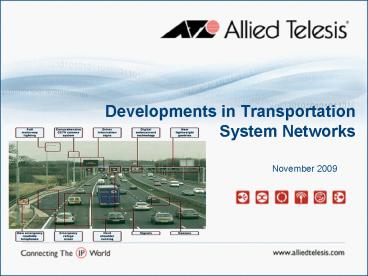Developments in Transportation System Networks PowerPoint PPT Presentation
1 / 20
Title: Developments in Transportation System Networks
1
Developments in Transportation System Networks
November 2009
2
Intelligent Transport Systems (ITS)
- Term generally applied to technology used to
reduce congestion and improve safety in transport
most often road transport - Not a new idea has been around since 1960s
- Variable-message signs in use since 1960s
- SCATS, SCOOT, TRAC traffic light control
developed in 1970s (and still in use today) - Intelligent transport society of America founded
in 1991 - Intelligent transportation systems given radio
spectrum spot by FCC in 1999 Dedicated Short
Range Communication (DSRC)
3
Convergence onto IP/Ethernet
- During the 2000s, the elements of ITS have
amalgamated onto a single communication system
for - CCTV
- VoIP
- Variable sign control
- On-ramp metering
- Toll-booth systems
- Microwave vehicle detection systems
- Even bridge movement detection
4
Active traffic management
- Integrated data and coordinated access to
signs/controls enables the following actions
dynamically in response to conditions - Speed control
- Route control
- Quickly clearing traffic out of lanes
- Opening outer lane
- Turning on-ramp controls on/off
5
Next step - Communicate with the vehicle
- Current methods communicate with the driver
- Aimed mostly at congestion reduction
- Now the scope is broadening to take in safety
- To make serious safety gains, it is necessary to
communicate with the vehicle - Machines can react more quickly than people
6
Vehicle communications
- Vehicle to Vehicle (V2V)
- vehicles to be informed of braking action of
vehicles in front - vehicles warn oncoming traffic of icy patches.
- emergency vehicles alert other vehicles of their
approach - awareness of vehicles in blind spot
- Vehicle to Infrastructure (V2I)
- infotainment
- Navigation
- Internet Access
7
Vehicle communications
8
The Car as a LAN
Low-speed data buses between electronic
components being replaced by ethernet Driven
by software upload times in repair shops
Ethernet-connected entertainment devices
installed Ethernet for external
communication
9
Mobile IP evolution
- Mobile IPv4 RFC 2002 (1996)
- Defined Mobile Node, Home Agent, Foreign Agent,
Home Address, Care-of Address - Mobile nodes data tunnelled between Foreign
Agent and Home Agent - Protocol details refined in later RFCs
- Mobile IPv6 RFC 3775 (2004)
- No need for foreign agent
- No IP-in-IP encapsulation uses IPv6 extension
headers - Supports route optimization direct
communication no via home network - Uses inherent security headers
- IPv6 provides superior mobility solution to IPv4
10
Mobile IP evolution cont.
- NEMO RFC 3963 (2005)
- Mobility for whole subnets, not just individual
hosts hence NEtwork MObility - Does not support route optimization
- Does support nesting of mobile subnets
- Suitable protocol for the V2I communication of
In-car LANs
11
NEMO problems to be solved
- Handover latency
- Acquiring new address in new foreign network
- Re-establishing connection with home agent
- Routing inefficiency and Extension header
overheads - Required to communicate via home network
- Extreme case aeroplane moving a network 1000s
of miles - Need to introduce route optimization
- IPSec overheads
- Move to certificate-based key negotiation
12
Layer-1 and Layer-2 communications
- IEEE 802.11 Task Group p has developed 802.11p
known as Wireless Access in Vehicular
Environments (WAVE) - Supports rapidly changing environment
- Provides fast connection establishment
- No need to agree on SSID, just use a wildcard
- Uses DSRC spectrum
- Developed with road safety applications as
primary goal - Acceptance that carrying commercial services
required to speed uptake
13
VANETs
- Vehicular ad-hoc Networks
- Groups of vehicles forming adhoc connections
using 802.11p - V2V and V2I connections
14
Geographic routing - GeoNet
- Geographic routing applied specifically to VANETs
- Uses the geographic position and movement
information of vehicles to route data packets. - Each node maintains a location table including
location related information for itself and a
list of its neighbouring nodes. - Position information, including speed and
direction, exchanged in beacon packets - Forwarding uses Greedy Perimeter Stateless
Routing (GPSR) protocol
15
GeoNet cont.
- Communication modes
- GeoUnicast from a node to a known location
- GeoAnyCast from a node to any node in a
geographic area - GeoBroadCast from a node to all nodes in
a geographic area - Topo-Broadcast from a node to all nodes
a given number of hops away
16
GeoNet protocol stack
17
Security challenge
- Inter-vehicle communications must be secure
- Hackers could cause severe problems
- Communication relayed through intermediate
vehicles requires privacy - But very challenging environment for security
- Require fast inter-vehicle connection
establishment - Vehicles must collaborate to forward traffic
- Very little knowledge of neighbouring nodes
- Not guaranteed access to PKI certificate
authorities
18
Privacy
- If vehicles are too easily identified, they can
be tracked, for malign purposes - Need to use multiple certificates, and swap
between certificates at random intervals - Need to generate multiple IPv6 addresses, and
swap between certificates at random intervals
19
Active bodies
- C2C-CC Car to Car Communication Consortium
- non-profit organisation initiated by six
European car manufacturers aiming to develop
a open industrial standard for inter-vehicle
communication - CVIS Cooperative Vehicle Infrastructure Systems
- consortium of 60 vehicle and parts
manufacturers, universities, research institutes,
national road administrations. To develop
standards and components for V2V and V2I
communications - SeVeCom Secure Vehiclar Communications
- EU-funded project that focuses on providing a
full definition and implementation of security
requirements for vehicular communications.
20
Active bodies cont.
- JARI - Japan Automobile Research Institute
- IETF, ETSI, ITU, IEEE, ISO, etc
- ISO working Group CALM Continuous
Air-Interface Long and Medium range - Defining protocols, management interfaces,
interoperability, for V2V and V2I communications
over a variety of media

